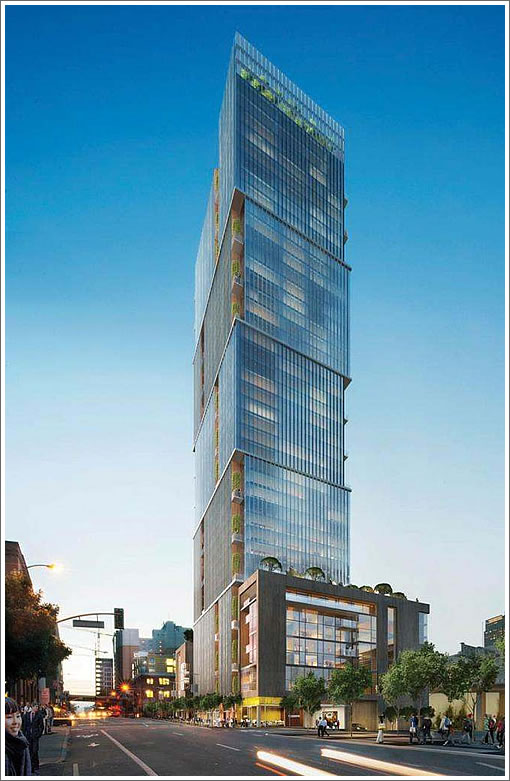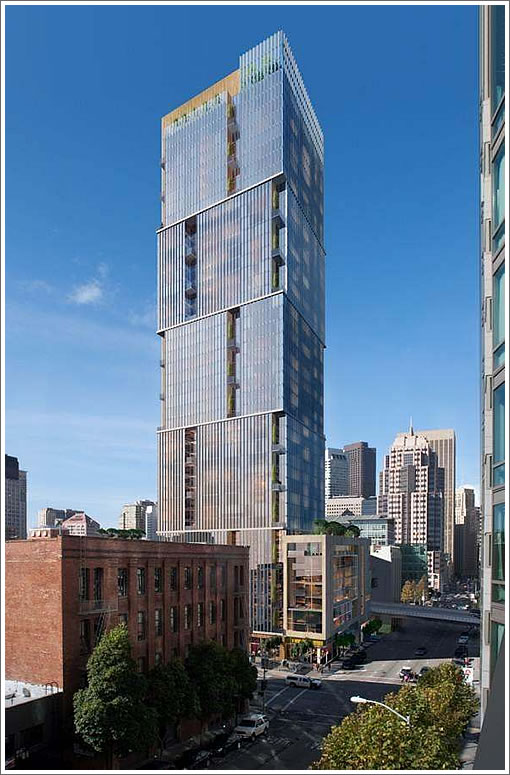
With a design by SOM and rendered by steeleblue, Avant Housing and Essex Property Trust have been selected by The Successor Agency to the San Francisco Redevelopment Agency to develop Transbay District Block 9 along Folsom Street.

On the site between First and Essex Streets, a 400-foot tower and 85-foot podium will rise with 563 housing units, 25 percent of which will be below market rate.
What would make this 3X better is if it was 3X higher. A 1200 ft tower would be perfect
Love it. A nice addition to the skyline.
Love it, and totally fine with the height. Just wish there were hundreds more 400-500 foot parcels available. We don’t really need more supertalls (not much need for those economically), but we could use several thousand more medium height skyscrapers full of homes/offices.
One of the more inspired designs being built in this city. Though, this really should’ve been at least a couple of hundred feet higher.
love it too.
Well done.
I suddenly have an urge to play Jenga.
But people, think of all the shade this will cast! And the height is all wrong for San Francisco nimby blah blah blah! Plus it’s going to ruin my view of the blah blah nimby blah!
This is going to be right in front of my livingroom window and block some of my current panoramic downtown view….but once this building is completed it will improve my view with new dimension and scale. I like it!
“This is going to be right in front of my livingroom window and block some of my current panoramic downtown view….but once this building is completed it will improve my view with new dimension and scale. I like it!” -Matteo
Now that’s the right attitude. I wish NIMBYs would realize that things are ever changing, and they don’t own the world around them.
This is a great looking tower.
I live at the Metropolitan and this will block my views too. But I wholeheartedly support more development in my neighborhood for the added foot traffic and the additional ground floor retail that it will hopefully bring. Here’s to making Rincon Hill a densely populated neighborhood!
Definitely love this…SF is in need of something of this quality and stature.
I’m usually not a fan of tiny, windswept balconies at such heights (that’s just my fear of heights talking), but in this case their sporadic addition add a nice detailing to the overall look of the building. Had balconies been incorporated on every floor it would have detracted from the look.
Is it 400′ total or 485′?
I like it:
1) Good densiity addition for this location.
2) Very nice use of the tower and podium form.
The podium (visually) gounds the bcuilding and provides a nice street wall for the pedestrian space. The tower seems to be simple yet has certain energy to it. It seems to be twisitng…at a pleasing rate.
Well done….
Yes, this is awesome. I live in One Rincon now and while I love everything about the building, I’d love to see more retail space, foot traffic, and “life”. I don’t mind walking to King street or Spear/Embarc for a watering hole, but it would be great to just walk a block or two (and maybe when the second Rincon tower is finished). I can’t wait to see what the neighborhood will look like in five-ten years.
Great looking development!
It is almost strange that retail spaces like the old Sharper Image store at Spear and Folsom sit empty in a neighborhood with over 6,000 residents within a 5 minute walk who tend to have exceptionally above median incomes.
Meanwhile, need to get the City to run the 12-Folsom bus route just 4 more blocks further east to Main Street so that our “transit oriented development” Rincon neighborhood connects by bus to the restaurants, night clubs, and grocery stores of West SoMa and the Mission.
I realize I’m probably in the minority here, but I really don’t see anything special about this. Something about it just feels knockoff-ish. Trinity Plaza maybe? Perhaps it will look better in real life.
When is this to be built?
Absolutely love it! I’m a huge mid-century modern fan and I feel this is a modern version of it….can’t wait.
Absolutely love it! A great throwback to mid-century modern!!
Congrats Eric!
kg – When is this to be built?
“Avant Housing and equity partner Essex Property Trust have been tapped to build a 400-foot tower on Block 9 in the Transbay District, a 563-unit project that could break ground a year from now.”
I notice that virtually all the residential towers in the area are around 350 – 400 feet and about 38 stories high. An unattractive table-top look is already apparent from the Bridge in SOMA. It’s only going to get worse.
San Francisco will continue to have the most unattractive skyline of any major US city.
^Meh.
I care much more for how a city looks and functions to people actually in the city and using it than to how it looks on postcards. To each his own I guess, but not a major (or even minor) concern to me.
“San Francisco will continue to have the most unattractive skyline of any major US city.” -Tobias
Holy exaggeration, Batman.
With that many bmr’s in these transbay blocks, I can’t imagine the market rate portion would get top dollar.
I do like the design though. What’s the parking ratio? Valet?
I don’t know the full story on BMR housing. Does the city pay out tax dollars to compensate the developer for BMR pricing, or does the seller need to commit to BMR units to get approval to build? And if the latter, I suppose the developer just raises the market rate units to compensate for the BMR units?
Overall, sounds like a great way to distort pricing and inefficiently redistribute income. Why not just implement more dramatic progressive tax policies for city residents?
The developer eats the BMR costs.
But the developer cannot just “raise the market rate units to compensate for the BMR unit.” The market sets the prices, and the developer charges as much as he can, but he can’t get more than that!
Nonsense. The developer doesn’t “eat” any costs. The marginal costs of regulatorily-required BMR units go into the overall cost of the building, and therefore from an accounting perspective constitute overhead.
The developer can’t sell individual elevators at market rate either, but that doesn’t mean the developer “eats” the costs of that or any other building features required by the Americans with Disabilities Act.
I wouldn’t get all tied up in knots over nomenclature. The developer’s construction costs include all costs for land, engineering, permits, the building itself, mechanical, fixtures, finishes, etc. etc. I’m sure its an endless list.
One could, colloquially, say that the builder “eats” all those costs… they are after all a normal cost of doing business. Which of course includes the cost of building BMR units.
None of the above costs bear any direct relation to the market price at which the units can be sold.
I assume BMR units aren’t sold, but rented out. So how does it work, does the developer have to sell those units to the city so they can rent them out, or does the developer become a landlord?
Either way, it seems obvious that the presence of BMR units puts margin pressure on the market rate units. And it’s a double whammy because “the market” doesn’t like units that are in close proximity to BMR tenants. One way or another we’re all paying for the privilege of keeping poor people in the city.
formidable doer, yes, you assumed incorrectly and revealed you’re underinformed. There are all kinds of BMR condos available and intended for sale and not for lease.
And for the condos we’re talking about, we also can’t assume that the buyers are “poor people” to be kept in the city, they’re mostly middle class people who have to meet stringent financial requirements in order to qualify.
@formidable doer – most of the current BMR units are for folks making 80-120% of area median income, meaning somewhere around 100k a year. Not exactly “poor” people, though certainly not wealthy by SF standards.
BMR units are not to be confused with old projects that had people making 10% of area median income.
And we’re not “all paying for the privilege of keeping poor people in the city”.
We’ve already dispensed with the idea that residents of BMR units are all or even mostly “poor people”, but the entire idea of the BMR program being funded by approaches such as in-lieu fees and not sales taxes is that the funding is being provided by the developers of new condos.
Now, you might believe that developers are able to pass on 100% of those costs to buyers (if you are, please see the 2nd ‘graph of ‘anon’-s comment above at 11:07 AM). Even if that were true, however, all that means is that new buyers of condos are footing the bill to keep San Francisco from becoming an adult disneyland for the rich, and that population doesn’t at all equal “all” of San Francisco.
In fact, if we assume for the sake of argument that the marginal increase in nominal selling prices for condos due to the need to cover the overhead of requlatorily-required BMR units is passed on to buyers wholesale, that means The City is collecting higher property taxes on those units due to the increased assessed value, and that increase in property taxes DOES redoubt to all San Franciscans who utilize city-provided services (I don’t buy that, but it follows logically).
And that’s the express purpose of the policy.
For example, if condo developers can’t seem to become interested in much other than luxury condo projects, and some members of the chinese “red nobility” want to buy units at the Infinity or the Millenium because they have so much cash they don’t know what to do with it all and everybody knows that foreign real estate in a “hot” market like S.F. is a great way to stash (read: launder) their money, well, the sensible response would be for the S.F. Board of Supervisors to say, “thank you” and put those funds to use for the good of San Franciscans.
Which is what they did when they created the Inclusionary Affordable Housing Program. Good for them.